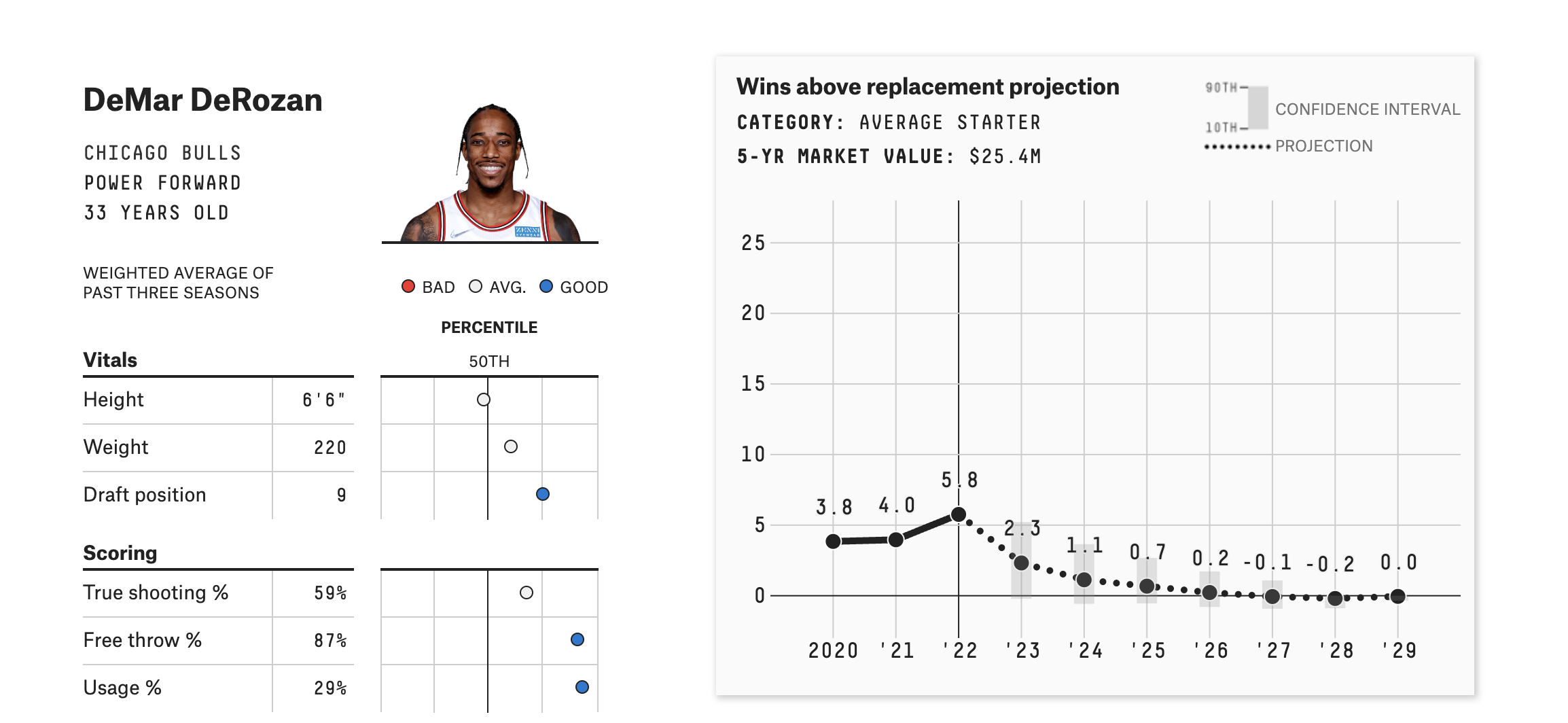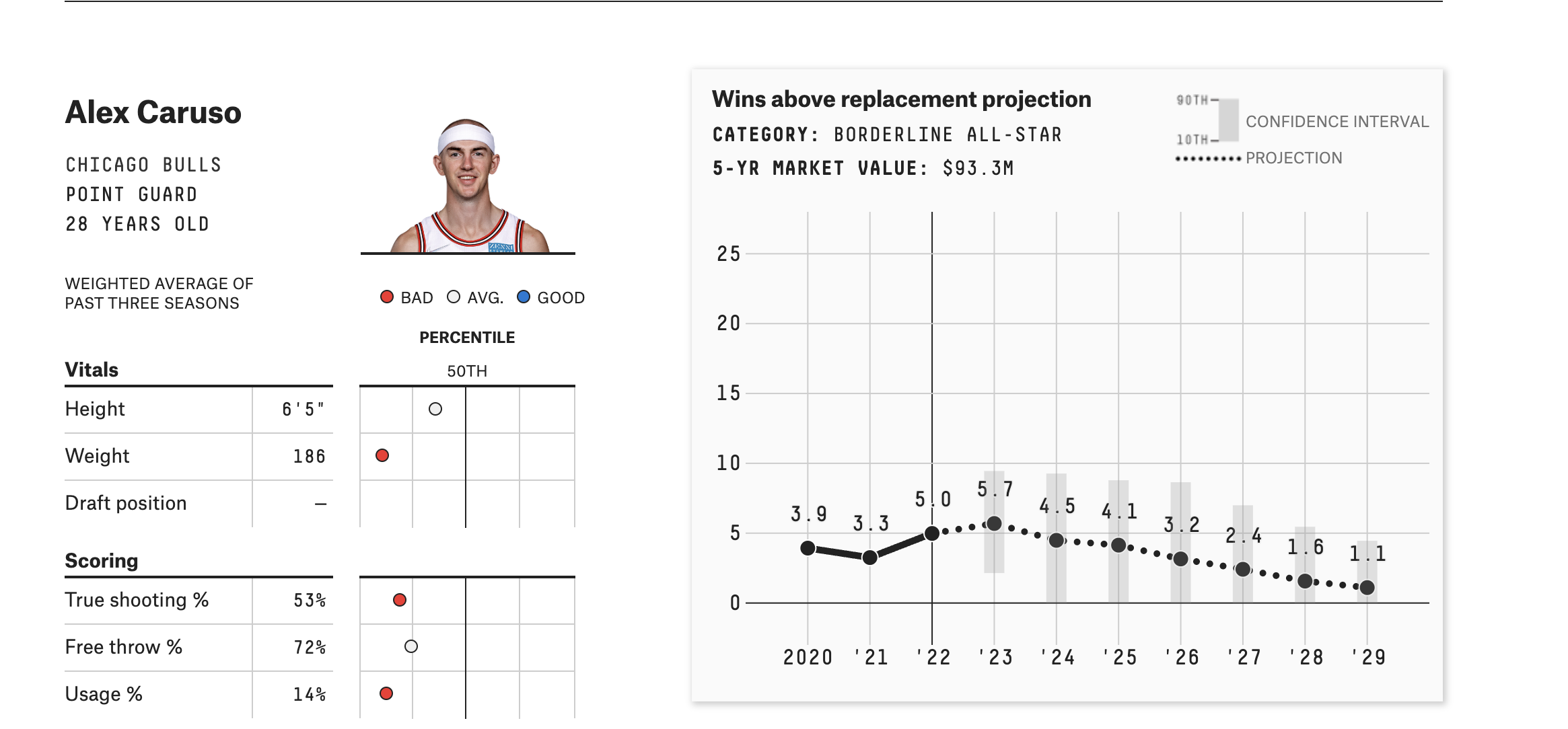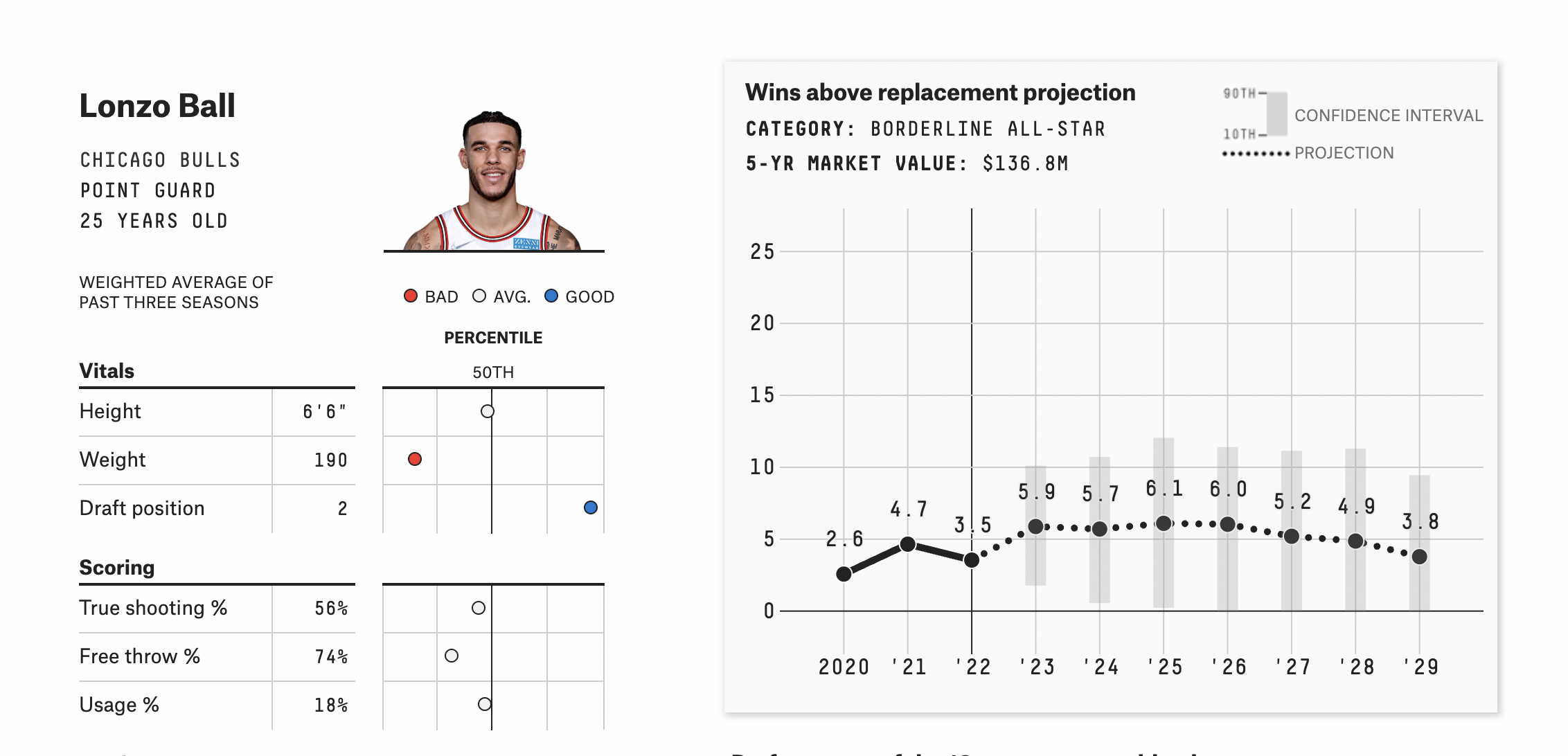© 2025 ALLCITY Network Inc.
All rights reserved.

Every year for the past few, Five Thirty Eigh, ESPN’s statsy, nerd child, puts together some juicy projections for every NBA player’s market value.
The idea is to put a dollar value on production over a five-year contract time horizon, using their RAPTOR statistic as a measuring stick. You can read more about what goes into their formula here, but in short, it looks at how the team performed with and without the player on the floor, scoring efficiency, usage, and steal, block and rebound rate.
Typically, these all-in-one stats tend to favor defensive impact, scoring efficiency and on/off performance the most, so it can pick favorites or pick on players who do one of those things well, but not the others.
Let’s see how their brand new 2022-23 projections rate the core members of the Bulls.
The Bad
Let’s kick it off with Zach LaVine, fresh off signing his $215 million deal. RAPTOR straight up disagrees.

This projects LaVine out as an “average starter” whose five-year market value is $64 million. Did the Bulls overpay LaVine by $150 million?
LaVine is clearly hurt here by his average rebound and block rates, and below-average steal and defensive plus-minus. But he’s a high-volume, high-efficiency scorer who is about to enter his prime being treated like a souped-up Jordan Clarkson.
DeMar DeRozan also had a strange projection, rated again as an “average starter” which should be five-years, $25.4 million. He’s set to make $27.3 million this upcoming season alone.

At least for DeRozan, you can point to his age and make an assumption there will be some drop off from his All-World performance last year. But still, a massive slap in the face for what he accomplished last year and what he should be able to do this upcoming season.
Nikola Vucevic also rated as an average starter worth $61.3 million over five years.

Another example of an older player exiting his prime who is defensively limited and had a down shooting season. $12.26 million annually actually seems about right for him, maybe slightly low. If the Bulls are able to extend him on that number, I think they’d be pretty happy about it.
The Good
While the offensive engines of the team do not rate out well, players like Alex Caruso and Lonzo Ball are stars in their roles. Borderline All-Stars, anyway.
Both Caruso and Ball rate out as “Borderline All-Stars”, whose market values are set at $93.3 and $136.8 million respectively.
Caruso signed a 4-year, $36.98 million deal with the Bulls, meaning the Bulls are paying Caruso half of what he’s worth, according to this model. Caruso was absolutely awesome this year and one of the best free agent signings of his class. Getting him on the mid-level exception was an absolute steal.

Ball’s contract was worth $80 million over four seasons so the Bulls, according to this metric, got a $7.36 million discount annually.

That’s probably about right when you factor in the injury risk. Ball is still young and improving. If he can stay healthy, he will continue to smash this and raise that number even more.
The Prospects
There isn’t a whole lot to say about the young players here, just because the Bulls crop of prospects hasn’t done much yet.
Patrick Williams is a “project” worth $39.5 million over five years while Dalen Terry‘s five-year market value is $43.7 million. These are mostly youth and upside based. Those numbers will probably change a lot before they’re ready to sign new deals with the Bulls.
More interest are the upcoming contract guys. Let’s start with Ayo Dosunmu who is a “rotation” piece worth $46.0 million over five seasons. Because Dosunmu was a second round pick, the Bulls were only able to offer him a two-year deal. He will actually be up for an extension after this season and I think $9.2 annually is perfect for him. That would require the full mid-level exception next season — perhaps a good reason for the Bulls to stay away from the Luxury Tax this year.
The Bulls have also have an interesting dilemma on their hands of what to do with Coby White, whose five year market value is set at $56.1 million. That number is a bit high for me considering he hasn’t proven to be consistent in his role. It’s also set about $8 million below LaVine’s worth, which…lol.
I think the consensus has swung way too far against White. He’s not good yet, but the Bulls need shooting. They can’t just give him away, but they also cannot really afford to pay him without going into the tax next year. They’ll probably look to trade him at the deadline, or in a Lauri Markkanen-type restricted free agency sign-and-trade.
The Others
Here’s what the rest of the Bulls rotation looks like:
Andre Drummond is a “key role player” worth five years, $46.2 million
Derrick Jones Jr. is a “rotation player” at five years, $23.3 million
Javonte Green is also a rotation player at five years, $34.2 million
Goran Dragic is listed as a “scrappy vet” worth $7.4 million over five seasons
Quick Thoughts
To me, if there are things that are this off in the model, you should probably change the model.
LaVine and DeRozan are imperfect players, but what I disagree with most on these kinds of projections is that it implies they aren’t worth having unless their market rate is reflected.
You don’t just pick up star players off the scrap heap. You need to pay or trade picks or both to get these guys. And once you have them, you do what you need to in order to keep them. I don’t really care what the number is for either because the Bulls have nothing without them.
At the same time, players like Caruso and Ball, as star role players, will never get paid the same way as offensive engines. So where I think the big three got hit a bit unfairly on their projections, it’s times like these where Ball and Caruso’s impact is well reflected.
Role players are role players for a reason. And even if they are really good at what they do, and Caruso and Ball are among the best, the offensive engines are what makes the whole thing go, and inherently need to be paid to do that job. It’s a lot harder to be good at that than it is to be good as a three-and-D wing, even though both jobs are important.
These models are a lot of fun and good places to start when thinking about player value. But context is really important and while RAPTOR tries to factor everything in, it clearly misses on some of these. To improve upon this, I think they should incorporate some kind of filter that adjusts for role, where offensive engines are in one bracket, role players have their own bracket and projects are in another.
Get Chicago's Best Sports Content In Your Inbox!Become a smarter Chicago sports fan with the latest game recaps, analysis and exclusive content from CHGO’s writers and podcasters!
Just drop your email below!
Comments
Share your thoughts
Join the conversation


